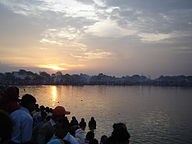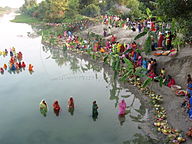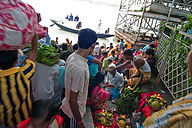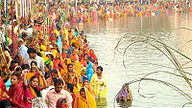- Chhath
-
Chhath 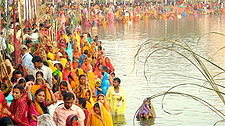
Performing of morning puja to Surya.Also called Chhathi
Dala Chhath
Surya ShashtiObserved by Hindus, and Jains Type Cultural, Historical, Religious Significance To thank Surya for bestowing the bounties of life on earth and fulfilling particular wishes Begins 2 days prior to Kartik Shasti Ends The day after Kartik Shasti Date Kartik Shukla Shasti 2010 date 10 November (Day1: Naha Kha)
- 11 November (Day2: Kharna)
- 12 November (Day3: Sanjhiya Arghya)
- 13 November (Day4: Paran-Bihaniya Arghya)
2011 date 1 November 2012 date 19 November Observances Prayers and religious rituals, including puja and prasad, bathing in the Ganges, and fasting Chhath (Hindi: छठ, also called Dala Chhath) is an ancient Hindu festival dedicated to the Hindu Sun God, Surya, also known as Surya Shashti.[1] The Chhath Puja is performed in order to thank Surya for sustaining life on earth and to request the granting of certain wishes. The Sun, considered the god of energy and of the life-force, is worshiped during the Chhath fesival to promote well-being, prosperity and progress. In Hinduism, Sun worship is believed to help cure a variety of diseases, including leprosy, and helps ensure the longevity and prosperity of family members, friends, and elders.
The rituals of the festival are rigorous and are observed over a period of four days. They include holy bathing, fasting and abstaining from drinking water (Vratta), standing in water for long periods of time, and offering prashad (prayer offerings) and aragh to the setting and rising sun.
Although it is observed most elaborately in Bihar, Jharkhand and the Terai regions of Nepal in modern times, and is more prevalent in areas where migrants from those areas have a presence, it is celebrated in all regions and major urban centers in India. The festival is celebrated in the regions including but not exclusive to the northeast region of India, Madhya Pradesh, Uttar Pradesh, Chhattisgarh, Chandigarh, Gujarat,[2] Delhi,[3] Mumbai[4] and Mauritius.[5]
Contents
Date of the festival
Chhath puja is performed on kartika Shukala Shashti, which is the sixth day of the month of Kartika in the Hindu Calendar. This falls typically in the month of October or November in the Gregorian Calendar.
It is also celebrated in the summer (March–April), on Chaitra Shashti, some days after Holi; this event is called Chaiti Chhath.[6] The former is more popular because winter is the usual festive season in North India, and Chhath, being an arduous observance, requiring the worshipers to fast without water for around 36 hours continuously, is easier to undertake in the Indian winters.
Etymology
The word chhath denotes the number 6 in Hindi[7] and the festival is celebrated on the sixth day of the Hindu lunar month of KARTIKA. The word is a Prakrit derivation from the Sanskrit ṣaṣṭhi, meaning sixth.
History
It is believed that the Maga Purohits (modern days known as Shakya Dwipi Brahmins) were invited by local kings for their expertise in Sun worshiping. They started the tradition of Chhat Puja. Today Chhat Puja is celebrated specially in those places where Shakya Dwipi Brahmins are found.
It is believed that the ritual of Chhath puja may even predate the ancient Vedas texts, as the Rigveda contains hymns worshiping the Sun god and describes similar rituals. The rituals also find reference in the Sanskrit epic poem Mahābhārata in which Draupadi is depicted as observing similar rites.In the poem, Draupadi and the Pandavas, rulers of Hastinapur (modern Delhi), performed the Chhath ritual on the advice of noble sage Dhaumya. Through her worship of the Sun God, Draupadi was not only able to solve her immediate problems, but also helped the Pandavas later regain their lost kingdom.
It is also believed that Chhath was started by Karna, the son of Surya (Surya Putra Karna). Surya Putra Karna ruled over the Anga Desh (present day Munger district of Bihar) during the Mahabharat Age. He was a great warrior and fought against the Pandavas in the Kurukshetra War.
Its yogic/scientific history dates back to the Vedic times. The rishis of yore used this method to remain without any external intake of food as they were able to obtain energy directly from the sun's rays. This was done through the Chhath method.[8]The chhat puja is very popular in Dehri-On-Sone(Rohtas),Patna, Dev & Gaya. Now a days it is celebrated in approximately all parts of India. Chhath Pooja is also celebrated in Mangalore, Karnataka. People from Bihar & UP celebrate Chhath Pooja on Panambur Beach.
Chhathi Maiya
It is also said that the Goddess that is worshipped during the famous Chhath Puja is known as Chhathi Maiya. Chhathi Maiya is known as Usha in the Vedas. She is believed to be the consort of Surya, the sun god. Some scholars are of the view that she is only the beloved of Surya and some suggest that She is Surya’s wife.
Usha is the term used to refer to dawn – The first light of day. But in the Rig Veda she has more symbolic meaning. Symbolically Usha is the dawn of divine consciousness in the individual aspirant.
During the Chhath Puja, Chhathi Maiya is invoked to bless us with this divine consciousness which will help us to overcome all the troubles in the world – this bless will help us to Moksha or liberation.
Rituals and traditions
Chhath is a ritual bathing festival that follows a period of abstinence and ritual segregation of the worshiper from the main household for four days. During this period, the worshiper observes ritual purity, and sleeps on the floor on a single blanket.
This is the only holy festival which has no involvement of any pandit (priest). The devotees offer their prayers to the setting sun, and then the rising sun in celebrating its glory as the cycle of birth starts with death. It is seen as the most glorious form of Sun worship.
Bihar has a number of Sun temples, flanked by a surajkund or sacred pool of the Sun, forming a popular venue for the celebration of this festival.Patna,Bhagalpur,Munger, Haveli Kharagpur( Banahara) ,Samastipur,Dumka,sahibganj, Dev, Gaya, ranchi,Rampurhat are known popular for chhath puja.
The main worshipers, called Parvaitin (from Sanskrit parv, meaning 'occasion' or 'festival'), are usually women. However, a large number of men also observe this festival. The parvaitin pray for the well-being of their family, for prosperity and for offspring. Once a family starts performing Chhatt Puja, it is their duty to perform it every year and to pass it on to the following generations. The festival is skipped only if there happens to be a death in the family that year.
The prasad offerings include sweets(Thekua) and fruit offered in small bamboo winnows. The food is strictly vegetarian and it is cooked without salt, onions or garlic. Emphasis is put on maintaining the purity of the food.
- Day 1: Nahay khay (literally, bathe and eat)
On the first day of Chhath Puja, the devotees take a dip, preferably in the holy river Ganges, and carry home the holy water of the river Ganges to prepare the offerings. The house and surroundings are scrupulously cleaned. The parvaitin allows themselves only one meal on this day.It is also known as " kaddu-bhat" in some region.Generally Parvaitin eat kaddu, channa dal, and arwa chawal (non-boiled rice). Traditionally the food is cooked on soil stove & mango wood is used a fuel. Only bronze or soil utensils are used to prepare the food. But now a days steel utensils are also used in preparation of food.
- Day 2: Kharna or Lohanda (the day before Chhath)
On Panchami, the day before Chhath, the parvaitins observe a fast for the whole day, which ends in the evening a little after sunset. Just after the worship of earth, the offerings of Rasiao-kheer (rice delicacy), puris (deep-fried puffs of wheat flour) and bananas, are distributed among family and friends. From this day onwards, for the next 36 hours, the parvaitin goes on a fast without water.
- The traditional way of preparation of Kheer for parvaitin is without sugar. Only Jaggery is used in preparation of prasad for other family members & friends. The prasad is prepared by the parvaitin itself in the bronze or soil utensils only. While eating the prasad by parvaitin if any unwanted thing like small stone etc comes into the mouth immediately they have to stop eating without making any complain.
- Day 3: Chhath
Sanjhiya Arghya (evening offerings): The day is spent preparing the prasad (offerings) at home. On the eve of this day, the entire household accompanies the parvaitins to a riverbank, pond or a common large water body to make the offerings (Aragh) to the setting sun. It is during this phase of Chhath Puja that the devotees offer prayers to the just setting sun. Traditionally during the aragh the parvaitin should wear the single saree colored with turmeric. But now a days printed & colored sarees are also in use.
The occasion is almost a carnival. Besides the parvaitin, there are friends and family, and numerous participants and onlookers, all willing to help and receive the blessings of the worshipper. Ritual rendition of regional folk songs, carried on through oral transmission from mothers and mothers-in-law to daughters and daughters-in-law, are sung on this occasion.
The folk songs sung on the evening of Chhath reflect the culture, social structure, mythology and history of Bihar and Uttar Pradesh. Nowadays, modern Chhath songs, largely Bollywood film remixes, have caught on, but the old tradition still goes strong with a great degree of sanctity. The three main linguistic regions of Bihar (the Maithili, the Magadhi, and the Bhojpuri), and all the various dialects associated with these, have different folk songs; but have an underlying unity in their dedicated to Chhath. The minor nuances of the Chhath rituals, such as in the Kharna ritual, vary from region to region and across families, but still there is a fundamental similarity.
Kosi: On the night of day three, a colorful event of Kosi is held. Here, lighted earthen lamps are kept under a canopy of five sugarcane sticks. The five sticks signify the human body made of Panchatattva (the five great elements - earth, water, fire, air and ether). This is a symbolic ritual in Chhath Puja, performed especially in those families where marriage or childbirth has taken place recently. The lighted lamps signify the solar energy sustaining the human being. People perform this ritual at home, during late evening on day three after making the offering to the just setting sun. After that, it is done at the banks of the river on day four before making the offerings to the rising sun.
- Day 4: Paarun (the day after Chhath)
Bihaniya Aragh (next morning offerings): On the final day of Chhath Puja, the devotees, along with family and friends, go to the riverbank before sunrise, in order to make the offerings (Aragh) to the rising sun. The festival ends with the breaking of the fast by the parvaitin and friends visiting the houses of the devotees to receive the prashad. The chhath has so much importance that even millionaire beg for prasad at the Chhath ghat. This symbolizes that all persons are beggar in front of the almighty. Witnessing Chhath being celebrated at the crack of the dawn on a river bank is a beautiful, elating spiritual experience connecting the modern Indian to his ancient cultural roots.After aragh , Ganga maiya is worshipped.
Yogic viewpoint
There is also a yogic process of Chhath that may have been associated with the religious observance of Chhath puja, but the current religious observers of Chhath puja do not refer to the yogic process and may not even be aware of it. All the traditional rules of Chhath puja has also got some strong scientific reasons behind it & by following that maximum benefits can be gain.
The Yogic Philosophy of Chhath
According to yogic philosophy, the physical bodies of all the living organisms are highly sophisticated energy conducting channels. The solar bio-electricity starts flowing in the human body when it is exposed to solar radiations of specific wavelengths. Under particular physical and mental conditions, the absorption and conduction of this solar-bio-electricity increases. The processes and the rituals of the Chhath puja aim at preparing the body and the mind of the Vratti (devotee) for the process of cosmic solar energy infusion.[citation needed]
The scientific process similar to Chhath was used by the Rishis of yore for carrying out their austerities without any intake of solid or liquid diet. Using a process similar to the Chhath puja, they were able to absorb the energy needed for sustenance directly from the sun, instead of taking it indirectly through food and water.
The retina is a kind of photoelectric material, which emits subtle energy when exposed to light. Hence, very subtle electric energy starts flowing from the retina. This energy (photo-bio-electricity) is transmitted from the retina to the pineal gland by the optic nerves connecting the retina to the pineal gland, leading to its activation. The pineal gland is in close proximity with the pituitary and hypothalamus glands (together, three glands are called Triveni) due to which, the energy generated in this process starts impacting these glands. Consequently, the pranic activity becomes uniform, giving the Vratti good health and a calm mind.
Stages of Chhath (Conscious Photoenergization Process)
According to Yoga philosophy, the process of Chhath is divided into six stages of the Conscious Cosmic Solar Energy Infusion Technique (Conscious Photoenergization Process).[9]
Stage 1: Fasting and the discipline of cleanliness leads to detoxification of the body and mind. This stage prepares the body and mind of the Vratti (devotee) to receive the cosmic solar energy.
Stage 2: Standing in a water body with half the body (navel deep) in the water minimizes the leak of energy and helps the prana (psychic energy) to move up the sushumna (psychic channel in the spine).
Stage 3: Cosmic Solar Energy enters the Vratti’s pineal, pituitary and hypothalamus glands (Triveni complex) through the retina and optic nerves.
Stage 4: Activation of Triveni tri-glandular complex (pineal, pituitary and hypothalamus).
Stage 5: A kind of polarization of happens in the spine, which results in the Vratti’s gross and subtle bodies getting transformed into a cosmic powerhouse. This can also lead to the awakening of the latent psychic energy popularly known as the Kundalini Shakti.
Stage 6: The body of the Vratti (devotee) becomes a channel which conducts, recycles and transmits the energy into the entire universe.
Benefits of Chhath process
The Chhath process results in detoxification
The Chhath process stresses mental discipline. The discipline of mental purity is a result of this work. By employing a number of rituals, the vrattis focus on maintaining the cleanliness of the offerings and environment. Cleanliness is the most dominant thought that prevails in the minds of the devotees during Chhath.
This has a great detoxification effect on the body and the mind as mental moods can result in biochemical changes. Now comes the physical detoxification. The fasting paves the way for detoxification at a material level.
Detoxification helps in regularizing the flow of prana and makes the person more energetic. The natural immune system of the body spends much of its energy in fighting the toxins present in the body. By using the detoxification methods such as pranayam, meditation, yoga and Chhath practices, the amount of toxins present in the body can be reduced to a great extent. Thus, with reduction in the amount of toxins, the expenditure of energy also reduces and you feel more energetic. It improves the appearance of the skin. The eyesight can improve and the ageing process of the body slows down.
Benefits of Chhath Puja
Photo-electro-chemical effect: physical benefits
- The Chhath practice improves the immunity of the Vratti’s body.
- Antiseptic effect: Safe radiation of sunlight can help cure fungal and bacterial infections of the skin.
- Raktavardhak (increase in fighting power of blood): As a consequence of the practice of Chhath, the energy infused in the blood stream improves the performance of white blood cells.
- The solar energy has a great influence on the glands, which results in balanced secretion of hormones.
- Energy requirements are met by the solar energy directly. This will further detoxify the body.
Photo-electro-psychic effects: mental benefits
- A state of creative calmness will prevails in the mind.
- To a great extent, all negative responses have their origin in the disturbed flow of prana. With the pranic flow regularized, the duration and frequency of occurrences of anger, jealousy, and other negative emotions will be reduced.
- With patient and sincere practice, the psychic powers like intuition, healing, and telepathy awaken. This depends on the concentration with which the practice is undertaken.
Daily sun meditation (Chhath process)
In the fast lifestyle of the present times, it may not be possible to follow the Chhath process very often. The detoxification can be undertaken through pranayam, yoga, meditation and Conscious Photoenergization Process known as Chhath Dhyan Sadhana (CDS).
Chhath Dhyan Sadhana (CDS): Conscious Photoenergization Process
Assume a comfortable position (standing or sitting) with back and spine straight. With eyes closed, face the Sun. Inhale completely, as slowly as possible. Do not strain in making the breathing slow. Maintain your comfort level. As you breath in, visualize (feelingly experience) the cosmic solar energy entering through your eyes and moving to the pineal gland through optic nerves and charging the pineal–pituitary–hypothalamus complex. Now, as you exhale, visualize the cosmic solar energy flowing down the pineal gland and spreading throughout your body with a revitalizing effect.
Thus, the process starts with inhalation and ends in exhalation. This constitutes one round. It is suggested to start with five rounds (two minutes), and increase if time permits. On completion of the practice, thank the Sun for bestowing upon you the life giving solar energy. Thereafter, sit quietly for a minute, observing the good things in the environment around.
CDS should be practiced within one-hour window after sunrise or within one-hour window before sunset. Any person of any age can practice CDS. If you wish to practice CDS at any time other than sunrise or sunset, do not practice it in front of Sun. You can however, practice CDS in a room. Even a bed-ridden person can try and consciously draw in the solar energy while lying on the bed. With regular practice, he/she will notice an improvement in physical and mental health. For those who are not comfortable facing the sun, they can practice the technique in any room having proper ventilation. If you have time, you can also practice twice a day. Do not hurry in increasing the number of rounds, as there is no shortcut to success in this method. The nervous system of the body takes its own time in adapting and to be able to receive the energy.
Significance of emphasis on sunrise and Sunset periods
Only sunrise and sunset are the periods during which the majority of humans can safely obtain the solar energy directly from the Sun. However, there may be some exceptions. That is why, in Chhath puja, there is a tradition of offering Arghya to the Sun in late evening and in early morning. During these phases (one hour window after sunrise and before sunset), the ultraviolet radiation levels remain in safe limits.
Pictures of Chhath
- Chhath Puja
-
Morning worship at Jamshedpur, Jharkhand
-
View of a ghat in a village near Muzaffarpur, Bihar
-
Celebrations on the banks of the Ganges in Kolkata, West Bengal
References
- ^ http://www.aryabhatt.com/fast_fair_festival/Festivals/Chhath%20Festival.htm
- ^ "Surat 1 lakh to celebrate chhath puja". Jai Bihar. October 22, 2009. http://jaibihar.com/surat-1-lakh-to-celebrate-chhath-puja/13529/. Retrieved 2009-12-14.[dead link]
- ^ "15 lakh to observe Chhath Puja in Delhi". Jai Bihar. October 22, 2009. http://jaibihar.com/15-lakh-to-observe-chhath-puja-in-delhi/13535/. Retrieved 2009-12-14.[dead link]
- ^ "Juhu Beach decks up for worshiping the sun god". DNA India. October 24, 2009. http://www.dnaindia.com/mumbai/report_juhu-beach-decks-up-for-worshipping-the-sun-god_1302371. Retrieved 2009-12-14.
- ^ "Festive fervour reaches Fiji, Mauritius". The Telegraph - Calcutta(Kolkata). October 24, 2009. http://www.telegraphindia.com/1091024/jsp/jharkhand/story_11652080.jsp. Retrieved 2009-12-14.
- ^ "Chaiti Chhath to start today". Jai Bihar. March 30, 2009. http://jaibihar.com/chaiti-chhath-to-start-today/5784. Retrieved 2009-12-14.[dead link]
- ^ http://www.experiencefestival.com/etymology_of_india
- ^ Sri Chhath Mahaviggyaan (The Science of Chhath) by Yogishri Oumkaar
- ^ http://chhathpuja.webs.com/meaningofwordchhath.htm
External links
Festivals in the Hindu calendar Major festivals - Pongal (Makar Sankranti)
- Holi
- Rama Navami
- Krishna Janmashtami
- Maha Shivaratri
- Onam
- Ganesh Chaturthi
- Navratri (Mysore Dasara – Durga Puja – Vijayadashami)
- Diwali (Bhau-Beej)
- Chhath
- Vat Purnima

Regional New Year - Gudi Padwa (Marathi, Konkani)
- Ugadi (Telugu, Kannada)
- Cheti Chand (Sindhi)
- Bihu (Assamese)
- Vaisakhi (Punjabi)
- Vishuva Sankranti (Oriya)
- Pohela Boishakh (Bengali)
- Puthandu (Tamil)
- Vishu (Malayalee)
Holy days Holy periods Hinduism Portal Categories:- Festivals in India
- Hindu festivals
- Bihar
- Culture of Bihar
- Culture of Mithila
Wikimedia Foundation. 2010.


